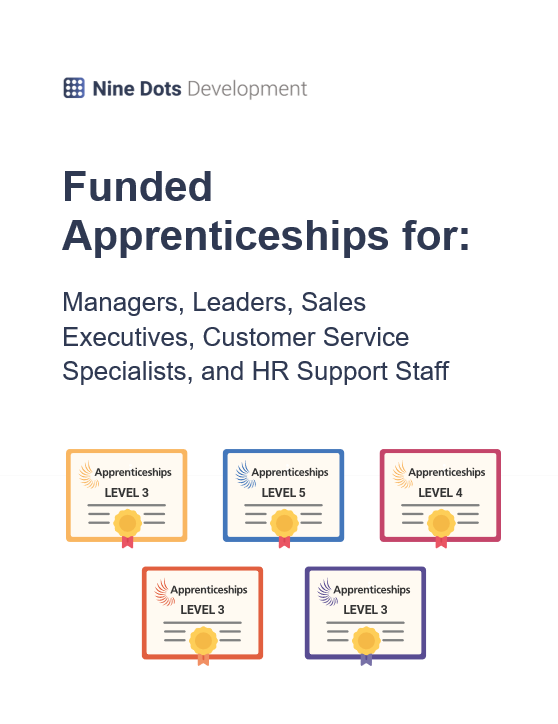Friday 17 Sep 2021 Article
The TakeawayHow to Help Your Employees Unlock the Career They Truly Desire
Why the Traditional Career Path Should be Challenged
Part 2
#FundedTraining #Leadership #Management #Sales #CustomerService #HR #Apprenticeships #CareerPath #PeopleDevelopment
The perfectly matched resource for this article...
Explore Our Funded Apprenticeships!
Please click the button below to download our brochure about any of the 5 apprenticeships below: - Level 3 Team Leader - Level 5 Operational Manager - Level 4 Sales Executive - Level 3 Customer Service Specialist - Level 3 Human Resources Support Staff
Download brochures!Playing catchup?
Part 1 How Career Paths Are Evolving
Part 2 How to Help Your Employees Unlock the Career They Truly Desire
How to Help Your Employees Unlock the Career They Truly Desire
As we discussed in the previous article of this series, the ‘typical’ career path has changed drastically over the years and employees now desire very different things from their careers than they did even just 10 years ago.
In today’s article, we touch on what a modern career path looks like compared to a traditional one, what now matters most to employees, and how you can help your staff unlock the career they truly desire.
How Career Paths Have Changed Over the Years
Traditionally, a desirable career path was the one with the least resistance. Staff used to be able to master one specific set of skills and make an entire career out of it by gaining experience and moving up the ranks to higher-paid positions. Employees would then typically stay with the same company for years, if not decades, and switching careers was very uncommon.
Today, career paths look very different; linear career paths are extremely rare, with the average person having 12 different jobs throughout their career. A modern career path isn’t necessarily a climb to one final destination, but rather a continuous journey of growth, learning, and improvement.
What Matters Most To Employees Today?
With employees becoming more and more willing to jump between different careers and companies, it is now more difficult, but also more important, than ever to keep them motivated and engaged. There are two types of motivators: intrinsic and extrinsic.
- Intrinsic motivators refer to doing something because it is inherently interesting or enjoyable. For example, giving an employee a certain task because you know they enjoy doing it.
- Extrinsic motivators refer to doing something because it leads to a separable outcome. For example, giving staff bonuses if sales exceed a certain number.
Whilst extrinsic motivators are important, they work best in the short term. For long term motivation and engagement, it’s best to focus on intrinsic motivators.
There are many different things that employees look for in their careers, five of the most important ones being: day-to-day fulfilment, flexibility, recognition, challenging work, and development opportunities.

Day-to-day Fulfillment
The traditional sign-posts of a successful career such as a high salary, a big office, and an impressive job title are no longer employees’ top priorities. Nowadays, employees strive to build a career that is fulfilling and filled with diverse, interesting experiences. Making sure that employees’ day-to-day tasks are varied and well suited to their strengths is key to infusing their work with a sense of meaning, making their job feel much more fulfilling. Also, putting a focus on how their work benefits the company as a whole makes employees’ roles feel much more purposeful, meaning that staff are more likely to work hard and go above and beyond to perform to their full potential.
Flexibility
It’s time to wave goodbye to the typical nine-to-five model. With staff prioritising their work-life balance more than ever, allowing flexibility is crucial to keeping staff motivated and satisfied. This flexibility could be in the form of different working hours to better suit their personal lives or, if that isn’t an option for your company, allowing staff to work from home more often if they wish to and if their role allows remote work. After all, as long as the work gets done, having a strict 9-5 model isn’t necessary. Different people work best at different times - some early birds produce their best work first thing in the morning, and others prefer to work in the evenings - so allowing this flexibility not only makes staff more satisfied, it can actually make them more productive.
Recognition
One of the most important factors that impacts how satisfied employees are with their job is recognition:
- 78% of employees cite recognition as the main motivating factor in their career
- 69% of employees would work harder if they were better recognised
- 52% are not satisfied with the level of recognition they receive
- 49% of employees would leave their current job for a company that better recognises their employees
You can click here to read one of our previous articles where we explored how to give impactful feedback and give employees recognition.

Challenging Work
Another key method of intrinsic motivation is to give employees challenging work. Managers often think that staff are happiest doing easy, low-effort work however, high-performing employees want work that stretches them and helps them learn new things. Setting ambitious goals for your employees and guiding them towards growth opportunities also helps gain buy-in for the work they are doing and engage staff - this is particularly important as 72% of current employees consider themselves to be disengaged at work.
Development Opportunities
Similarly, providing staff with development opportunities helps motivate them but also, it shows your care and investment in their career progression. This helps build better relationships with employees and an overall better work environment. 93% of employees say that they want “lifelong learning and are willing to spend their own time and/or money on further training”, showing just how important development is to them. The modern workforce doesn’t just want to spend their time earning a paycheck; they want to invest their time acquiring and improving the skills and knowledge they need to grow both personally and professionally.
Employees no longer see their career as a sprint to the top as quickly as possible; they see it as a marathon where they can gradually build their skills and expertise to benefit their career in the long term. Training no longer exists just to ensure that staff meet the minimum competency requirements, it exists to take their career to the next level and enable staff to reach the highest levels of performance.
{{ADVERT}}
How to Help Your Employees Unlock the Career They Truly Desire Through Training
With development opportunities evidently being at the top of employees’ priorities, have you got rich, long term, up-to-date training plans in place for your workforce?
If not, apprenticeships are a fantastic route to go down, allowing staff to learn and progress without taking them away from their day-to-day job. A modern day apprenticeship “combines hands-on work with the opportunity to train and obtain qualifications” and is available for almost any role in any industry. There is also incredible funding available for apprenticeships, with the ESFA funding up to 95% of the cost.

Professional, office-based apprenticeships are our speciality, and we currently offer 5 different apprenticeship programmes:
- Level 3 Team Leader
- Level 5 Operational Manager
- Level 4 Sales Executive
- Level 3 Customer Service Specialist
- Level 3 Human Resources Support Staff
If you’re interested in any of the above apprenticeships, you can click here to download our apprenticeship brochures or click here to request a call with one of our training experts.
---
Until next time...
Explore Our Funded Apprenticeships!
Please click the button below to download our brochure about any of the 5 apprenticeships below: - Level 3 Team Leader - Level 5 Operational Manager - Level 4 Sales Executive - Level 3 Customer Service Specialist - Level 3 Human Resources Support Staff
Download brochures!Missed an article? More from Why the Traditional Career Path Should be Challenged
Part 1 How Career Paths Are Evolving
Part 2 How to Help Your Employees Unlock the Career They Truly Desire

